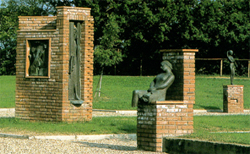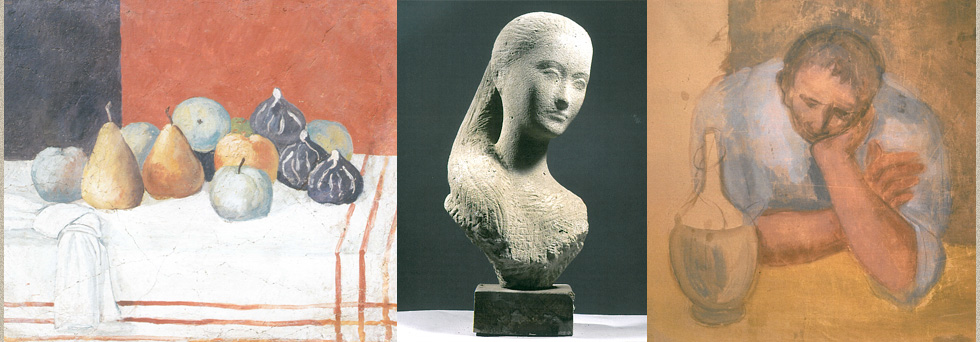
QUINTO MARTINI - THE MUSEUM-PARK From: Museum-Park Quinto Martini, Comune di Carmignano, 1997
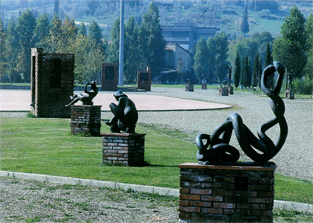 Museum-Park Quinto Martini, Comune di Carmignano, 1997
Museum-Park Quinto Martini, Comune di Carmignano, 1997
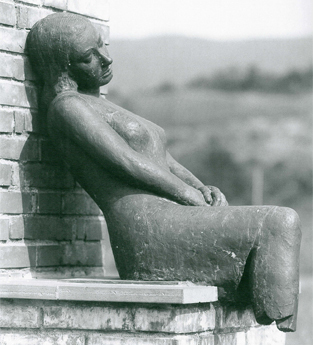 Sleeping Seano girl, 1933
Sleeping Seano girl, 1933Museum-Park Quinto Martini, Comune di Carmignano, 1997
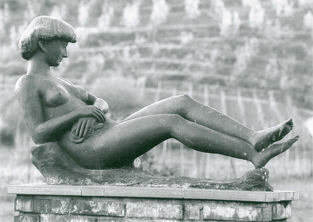 Alcea, 1942
Alcea, 1942Museum-Park Quinto Martini, Comune di Carmignano, 1997
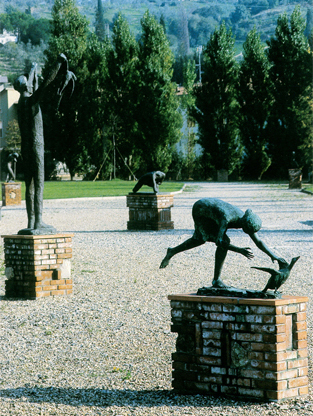 Museum-Park Quinto Martini, Comune di Carmignano, 1997
Museum-Park Quinto Martini, Comune di Carmignano, 1997
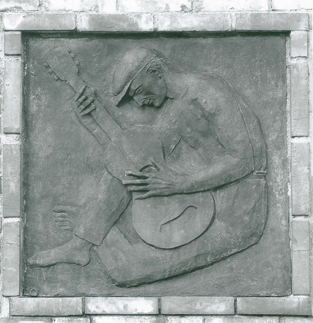 Guitar player, 1946
Guitar player, 1946Museum-Park Quinto Martini, Comune di Carmignano, 1997
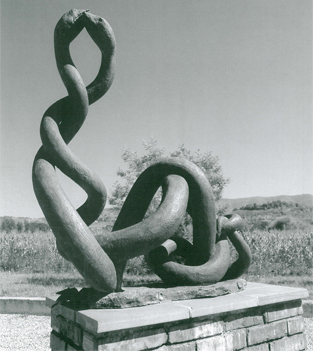 Mating serpents, Second half of the 1950s
Mating serpents, Second half of the 1950sMuseum-Park Quinto Martini, Comune di Carmignano, 1997
The Museum-Park, by Lucia Minunno
When Mayor Antonio Cirri's Carmignano City Council asked Quinto Martini Jèr a sculpture to embellish the town square of Seano, the artist proposed the idea not of a statue, "which would have remained isolated, cut off fr. om the surrounding environrnent, nor the great number of virtual bowling pins that stud so many other town squares in Italy, but sornething different, a boulder for example, a stone fr. agrnent that rnight have rolled down there by chance from a mountain top".1
This idea - later actually realized, although the stonework itself was carried out by Giuseppe Caselle - led to a more ambitious project, stili focused on renewing the concept of urban embellishment": Martini would donate a large number of sculptures to the Town, on condition that they be inserted in a "suitable space", with an arrangement "in keeping with the ,spirit of piace" and with an employment that would make of them the "benefit of all".
Thus the idea came into being of a "museurnpark" decorated with 36 bronze sculptures (cast from works created by the artist from 1931 to 1988), with spaces set aside for children's play activities and for meetings of the citizenry. The project was carried out by Ettore Chelazzi, who in the cited presentation wrote: "This flatland, in the evolution of this land area, has increasingly lost its original agricultural character, having become in part a site for factories and in part a site ear-marked r new residential construction. In the process of urbanization of the areas around the Seano nucleus there is a field - crossed by the Furba torrent which at this point flows clear that has remained untouched, abandoned now of any agricultural use but predisposed for a new dual-purpose employment: as a center of aggregation for the inhabitants. (...) and as an area of landscaped greenety".
The project 's purpose then was the realization of a square that would preserve "a field for public utilization", create a natural tableau with "the hills in the background, places of work and of culture" and supply "spaces [or amusement, physical exercise and a relation-ship with art", in which the art would be worthily represented by the works of Quinto Martini. The task of preparing and casting 36 sculptures was particularly fatiguing for the then seventy-year-old artist, since, despite his age, he insisted on personally seeing through the entire realization of the plaster models of the large statues and the bas-reliefs as well as the casting in bronze (almost all executed at the Salvadori Art Foundary of Pistoia), entrusting the final polishing to others only in one case (To My Mother, n. 66), as he claimed that "the statue belongs to him who smoothes it down".2
The completion of the work on the Museum-Park of Seano was due wholly to Martini's e orts: "I am attached to my land, to my people", he said, "and I derive my strength from them, the will and the passion to go on with tiny work"; "I arn no longer young (..) and my aspiration is to leave to my future citizens a sign, a remembrance of my passion for art": the "museum which will gather together my best works".3
And in fact the Museum-Park we find represented many of the artist's most treasured thetnes: from Alcea to the girl seizing a goose, from the mother with child to Friends, fr. om the seated innkeeper awaiting his custorners to the woman peeking irtto the street from her doorstep, to the mendicants, the .female torsos, the figures under the rain and Yatherhood", ali subjects drawn from the daily life of a country town - with the exception of the ,female nudes which are of a more "urban" refinement - which have precise correspondences in the artist's vast pictorial and graphic corpus. "At bottom", as Renzo Federici wrote for his above-cited pamphlet presenting the project, "it is fit-ting that such a huge selection of his vast production should return definitively among the hills where he grew up and where he stil periodically finds a primitive but extremely human refuge, to work under the immense sky, hoeing his garden and puttering ceaselessly with his trestles".
When in May of 1988 the Museurn-Park was inaugurated, Quinto Martini was justly proud of 14 get away from, and on account of this it is a greca fortune that my works should stay in Seano, the piace where I was born". My sculptures wish first of ali to express the simple vitality of this earth. Not therefore the delimitation of a museum, but an appropriate placement in that nature from which they emerged and where peo-ple can spend their leisure time (...). Every one of these statues resounds within me with a different timbre: different because of the memory of a particular situation, a particular state of mind, a different period of my life. When I come here each one speaks to me with its own voice, which simply my voice of that epoch. Every one of them is the child of a different moment, which at such a distance I would no longer even be able to recall clearly, perhaps because I have never given much importance to the registration of time or to what was going on around me".4
1 From the Presentation of the Museurn-Park with Sculptures by Quinto Martini, Seano lime 28, 1981.
2 For this purpose Martini chose Antonio Di Tommaso, a sculptor gifted with a great technical exactitude.
3 From an interview with the artist by Arrigo Cecchi for «La Nazione» of December 7, 1984.
4 From an interyiew by M. Moretti for «La Nazione», October 31, 1988, p.6.
Presentation of the project (June 28 1981), by Paolo Sica
I shall try to explain why the project of the Museum-Park of Seano is an important initiative, perhaps beyond what its promotors themselves have supposed. What does this project consist of ? In creating a central open space for different kinds of leisure activities, a multi-faceted space, a triangulation of diverse overlapping functions, a combination of natural and artificial materials, all animated by the group of sculptures donated by a Tuscan artist who was deeply linked to the local scene.
Each of these elements, taken by itself, could certainly find a place in projects and experiences actualized elsewhere; as a single unit, though, they constitute an exemplary phenomenon, and perhaps even an alternative one as regards current practice.
Firstly, these facilities constitute a significant increment of fixed social and existing public capital, helping to balance out the dialectic of urban development which is too heavily weighted toward a private appropriation of space (while it has been said, quite justly, that no true leisure can exist without free public space). There is a second aspect directly linked to the first: and this refers to the notion of socially oriented leisure time – with no consumer finality – made available to all, collectively. The metropolis – not only the metropolis, but the outskirts too, vacation spots, and even the interiors of our homes – are continually bombarded by the mass media which invite us to partake of an infinite individual comsumption of new object-spaces or new space-objects, exchange rather than use values; here, in this Seano project, leisure time, physical exercise, entertainment, converge upon a cultural qualification, immersed in a network of social relationships. The Museum-Park thus becomes an area of aggregation of a type so lacking in the contemporary city. One of the ways by which our cities – big and small – may be reclaimed in through our social services, which are among the most versatile sectors for triggering an innovative process, precisely because it is based on non-hierarchical facilities.
But there is one more very important fact. By having combined with this original collection of statuary a set of functions which constituting a clear response to so often neglected biological and social needs, the Museum-Park has become a very important nexus of identification for the small community of Seano, a symbolic, geographical reference point: in short, it qualifies itself as a 'presence" in the area's complex multiform reality, leading us to conceptualize its space in terms of "place". We could spend further high-sounding words on this point, but let us stop here: it is certain that the process of urbanization of the past thirty years, now partially in crisis, has not just brought economic depauperization to the outskirts and the countryside in contrast to the inner cities, but it has also greatly reduced or annulled the significant features of the socio-economic, spatial and productive context (at one time composed of fairs, markets, events and local traditions). Even on this front there is need for intelligent conservation, a new equilibrium. And those whose task it is to oversee the development of a contemporary city's organization, too often pressured by the crushing problems of the metropolis, should not ignore or underestimate the extent of these trends even in the smaller communities: not only because indifference to the overall processes of reorganization of the area's reality is counterproductive, and not only because a balanced urban development can truly be defined only on the level of the entire space set aside for popular habitation and use, but also because of the specific, immediate influence that certain initiatives, such as this one in Seano, can exert on the area's crucial problems.
And in this context the Museum-Park of Seano is truly alternative: since it serves as a proving ground for unusual values through the formulation of speculative urban concepts, and constitutes in this respect an anticipation, albeit partial, of a different kind of city environment.
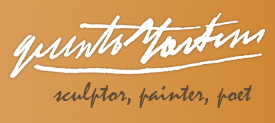
 ITALIANO
ITALIANO ENGLISH
ENGLISH